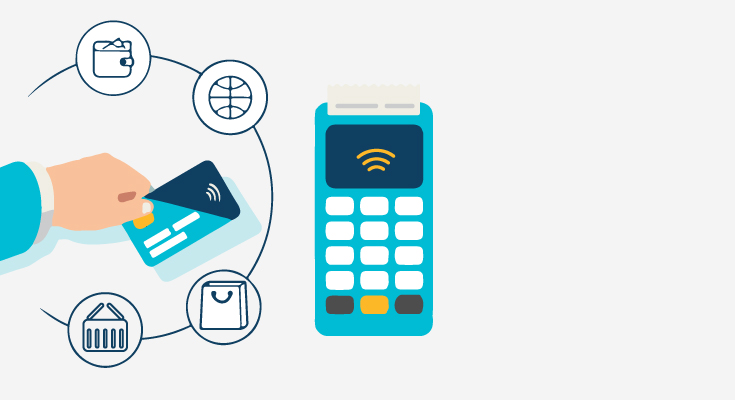Near-field communication (NFC) uses radio waves that are similar to radio frequency identification (RFDI), to read and send information between two NFC devices. NFC technologies are mostly used in warehousing labeling and they’re incredibly helpful in tracking applications for simple inventory scanning of shipments, products, and customer orders. NFC is even used in automated toll booths to collect information from crossing vehicles.
In the FinTech environment, NFC payments lead to contactless, encrypted, and streamlined payment methods. This payment method removes complexity from the process by eliminating the need of carrying cash, credit, and debit cards. Customers can use their smartphones to make purchases. NFC payments are relevant today with growing health and safety concerns.
While NFC technologies are pretty similar to RFID and Bluetooth technology. However, there are some major differences between how the technology is used in the FinTech environment. NFC payments in the FinTech landscape to ensure a streamlined and highly secure checkout process.
What’s an NFC Payment?
Not a lot of consumers know about NFC payments, chances are that you’ve seen these payments working in real-time. It could be advertisements, in person or for some person waiting in line in a store. With contactless payments becoming more and more famous, NFC payments are becoming a common method among consumers.
NFC payments are contactless and secure payments that use NFC technologies to exchange data between an NFC reader and an NFC payment device. Some common examples of these NFC payment devices are Apple Pay, Google Pay, eWallets, and EMV cars. NFC readers are the payment processors that you can use to make contactless payments anywhere. For an NFC payment to work, both the devices should be equipped with NFC chips.
Apple introduced Apple Pay with the launch of the iPhone 6 in 2014, and it quickly became a sensation. Some consider Apply Pay to be the birth of NFC payments. Since then, most smartphones come equipped with an NFC chip. When two devices with NFC chips are in close proximity with each other, radio waves transmit data to and from each other to complete a payment instantly. You have to hold your device close to process the payments because the NFC chips inside each device only work when they’re in close proximity to each other.
RFID can transmit data from up to 100 meters away, but the frequency used for NFC payments ensures you must be close by to communicate between devices. This makes sure that NFC chips nearby are unable to transmit data for secure payment processing.
Are NFC Mobile Payments Secure?
If you compare NFC payments to debit and credit card payments, they’re equally as secure. Here are some factors that will help you understand how secure NFC payments are?
- Device Proximity
NFC payments rely on a radio frequency of 13.56 MHz, and NFC payments happen only when two devices are incredibly close to each other. Consumers don’t need to worry about someone intercepting the signal to interrupt payments or steal data.
- User Initiation
A user needs to activate NFC in their device before making a payment. Users can secure this NFC activation process with a passcode, fingerprint, or facial unlock. This makes the NFC payments process extremely secure.
- Secure Element Authentication
This is what makes NFC payments incredibly secure. Once a user approves that they’re making an NFC payment, the data is transmitted and validated via a separate physical chip or cloud element known as the secure element. Secure elements are protected by a unique digital signature that relies on an OTP to move requested data.
- Encrypted Information
Any transmitted NFC payment information is encrypted and secured, this means a specific account or amount details can’t be hacked or cloned.
Why Should You Use NFC Payments?
There are several reasons to use NFC payments, the first being convenience. Businesses that use NFC payments are promoting themselves as NFC payments being their primary checkout process. Not just that, they allow customers to make payments without limiting them to cash, and card payments.
- Security
As with any electronic payment process, consumer security is the first and foremost concern. NFC payments are highly secure for both consumers and businesses. They leverage an identity verification required to even initiate payments.
- Payment Speed
Speeds of NFC payments are almost instantaneous similar to credit or debit cards. It takes just a few seconds for the information to be transmitted. This information is read by a secure element for authorization to process the payment.
- Convenience for Consumers
Consumers can now use smartphones to send and receive money. Most smartphones launched today come equipped with NFC chips, so they can make contactless payments. With NFC payments, consumers can make purchases even if they don’t have cash or cards with them.
Future of NFC Payments
Once NFC payments became a common practice, several services that revolve around NFC payments popped up in markets. The preference of NFC payments are at an all-time high. It only makes sense for mobile payment options to be available to consumers. There’s no need to carry debit or credit cards when you already have cash with you.





